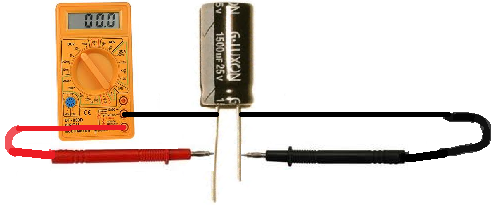How To Test a Capacitor

In this article, we will go over different tests that we can use to tell whether a capacitor is good or not, all by utilizing the functions of a digital multimeter.
There are many checks we can do to see if a capacitor is functioning the way it should. We will use and exploit the characteristics and behaviors that a capacitor should show if it is good and, in thus doing so, determine whether its is good or defective.
So let's start:
Test a Capacitor with an Ohmmeter of a Multimeter
A very good test you can do is to check a capacitor with your multimeter set on the ohmmeter setting.
By taking the capacitor's resistance, we can determine whether the capacitor is good or bad.
To do this test, We take the ohmmeter and place the probes across the leads of the capacitor. The orientation doesn't matter, because
resistance isn't polarized.

If we read a very low resistance (near 0Ω) across the capacitor, we know the capacitor is defective. It is reading as if there is a short circuit across it.
If we read a very high resistance across the capacitor (several MΩ), this is a sign that the capacitor likely is defective as well. It is reading as if there is an open circuit across the capacitor.
A normal capacitor would have a resistance reading up somewhere in between these 2 extremes, say, anywhere in the tens of thousands or hundreds of thousands of ohms. But not 0Ω or several MΩ.
This is a simple but effective method for finding out if a capacitor is defective or not.
Test a Capacitor with a Multimeter in the Capacitance Setting
Another check you can do is check the capacitance of the capacitor with a multimeter, if you have a capacitance meter on your multimeter. All you have to do is read the capacitance that is on the exterior of the capacitor and take the multimeter probes and place them on the leads of the capacitor. Polarity doesn't matter.
This is the same as the how the setup is for the first illustration, only now the multimeter is set to the capacitance setting.
You should read a value near the capacitance rating of the capacitor. Due to tolerance and the fact that (specifically, electrolytic capacitors) may dry up, you may read a little less in value than the capacitance of the rating. This is fine. If it is a little lower, it is still a good capacitor. However, if you read a significantly lower capacitance or none at all, this is a sure sign that the capacitor is defective and needs to be replaced.
Checking the capacitance of a capacitor is a great test for determining whether a capacitor is good or not.
Test a Capacitor with a Voltmeter
Another test you can do to check if a capacitor is good or not is a voltage test.
Afterall, capacitors are storage devices. They store a potential difference of charges across their plate, which are voltages. The anode has a positive voltage and the cathode has a negative voltage.
A test that you can do is to see if a capacitor is working as normal is to charge it up with a voltage and then read the
voltage across the terminals. If it reads the voltage that you charged it to, then the capacitor is doing its job and can
retain voltage across its terminals. If it is not charging up and reading voltage, this is a sign the capacitor is defective.

To charge the capacitor with voltage, apply DC voltage to the capacitor leads. Now polarity is very important for polarized capacitors (electrolytic capacitors). If you are dealing with a polarized capacitor, then you must observe polarity and the correct lead assignments. Positive voltage goes to the anode (the longer lead) of the capacitor and negative or ground goes to the cathode (the shorter lead) of the capacitor. Apply a voltage which is less than the voltage rating of the capacitor for a few seconds. For example, feed a 25V capacitor 9 volts and let the 9 volts charge it up for a few seconds. As long as you're not using a huge, huge capacitor, then it will charge in a very short period of time, just a few seconds. After the charge is finished, disconnect the capacitor from the voltage source and read its voltage with the multimeter. The voltage at first should read near the 9 volts (or whatever voltage) you fed it. Note that the voltage will discharge rapidly and head down to 0V because the capacitor is discharging its voltage through the multimeter. However, you should read the charged voltage value at first before it rapidly declines. This is the behavior of a healthy and a good capacitor. If it will not retain voltage, it is defective and should be replaced.
So there you have it, 3 strong tests that you can do (all or either/or) to test whether a capacitor is good or not.
Related Resources
Capacitor Code Calculator
Capacitance Calculator
Capacitor Impedance Calculator
